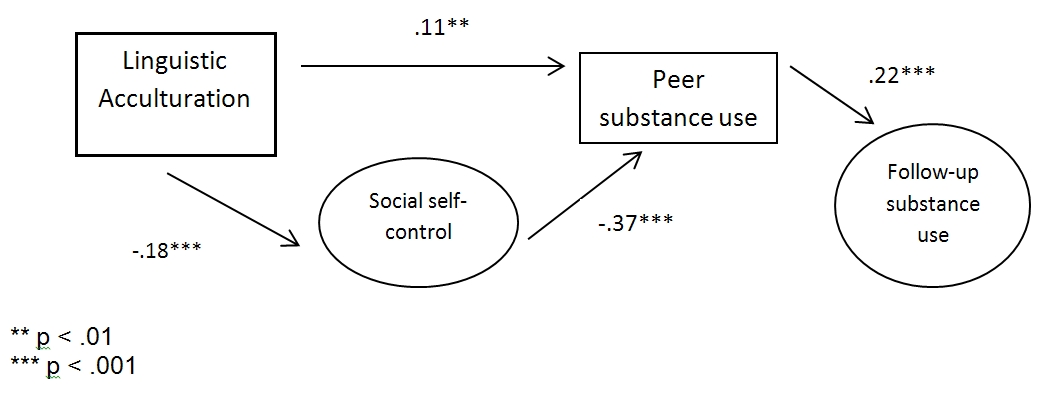STASH, Vol. 9(9) – Words with friends: Linguistic acculturation, self-control and peer drug use among Hispanic adolescents
Some studies have found that acculturation—the process by which immigrants adapt to a host culture—can predict risky drug use behavior. For example, greater English language (i.e., linguistic acculturation) use has been associated with more cigarette, alcohol, and illicit drug use among Hispanic adolescents (Unger et al., 2009; Myers et al., 2009). However, research has yet to determine the mechanisms through which acculturation leads to drug use behavior. In this week’s STASH, we review a study by Pokhrel and colleagues (2013), which examined whether social self-control, peer substance use, and personal substance use mediate the relationship between the acculturation of Hispanic high school students and risky drug use.
Methods
- Researchers recruited 1,040 Hispanic high school students from schools in Southern California. The students were taking part in a substance use prevention program.
- Students completed questionnaires at Baseline and a year later at Follow-up that included:
- Baseline linguistic acculturation, measured as a tendency towards using English (Example: “In general, what language(s) do you most often read and speak?”)
- Baseline social self-control (Example: “My mouth gets me in trouble a lot.”)
- Baseline peer drug use (Example: “In the last month, how many of your 5 closest friends have used each of the drugs below?”)
- Baseline and Follow-up past 30 day cigarette use, alcohol use, marijuana use, and other drug use (Example: “In the last month (last 30 days), how many times have you used each of the drugs below?”)
- 846 students who had identified themselves as Hispanic at Baseline completed the Follow-up survey. The retention rate among this group from Baseline to Follow-up was 81%.
- Researchers tested a model to predict current substance use from earlier self-reported acculturation. They specifically tested how Baseline social self-control, peer substance use, and personal substance use factored in to the relationship between acculturation and substance use at Follow-up.

Figure. Selected pathways from acculturation to follow-up substance use (adapted from Pokhrel et al, 2013). Values included are standardized coefficients (R2). Click image to enlarge.
Results
- There were two primary pathways from linguistic acculturation to substance use at Follow-up (Figure 1):
- At Baseline, youth who reported more linguistic acculturation tended to report lower social self-control, which was associated with greater peer substance use. Greater peer substance use was then associated with more substance use at Follow-up. More directly, youth who reported more linguistic acculturation at Baseline also experienced more substance use, through just increased peer substance use.
- Baseline personal substance use was not a key part of any tested pathway between acculturation and substance use at Follow-up.
Limitations
- Self-report questionnaires are susceptible to inaccuracy.
- Different measurements of acculturation might lead to different findings.
- The study could not look at the development of social self-control or acculturation over time, because both were assessed at Baseline, and so it might have missed some of the complexity of the relationship.
Conclusions
This study found support for the hypothesis that acculturation predicts greater substance use via a pathway that involves low social self-control and peer substance use. Among Hispanic teenagers, one possible explanation for the pathway between acculturation and lower social self-control is that embracing U.S. cultural values comes at the expense of native cultural values which emphasize respect, particularly toward elders. Then, those who have lower social self-control might form relationships with peers who use substances, setting them on a trajectory that increases risk for future personal substance use. Future studies could use longitudinal analysis to investigate how social self control and peer selection emerge over time. Interventions that target self-control and peer affiliation might be useful for reducing substance use among Hispanic teens.
-Kat Belkin
What do you think? Please use the comment link below to provide feedback on this article.
References
Pokhrel, P., Herzog, T.A., Sun, P., Rohrbach, L.A., Sussman, S. (2013). Acculturation, social self-control, and substance use among Hispanic adolescents. Psychology of Addictive Behaviors, in press.